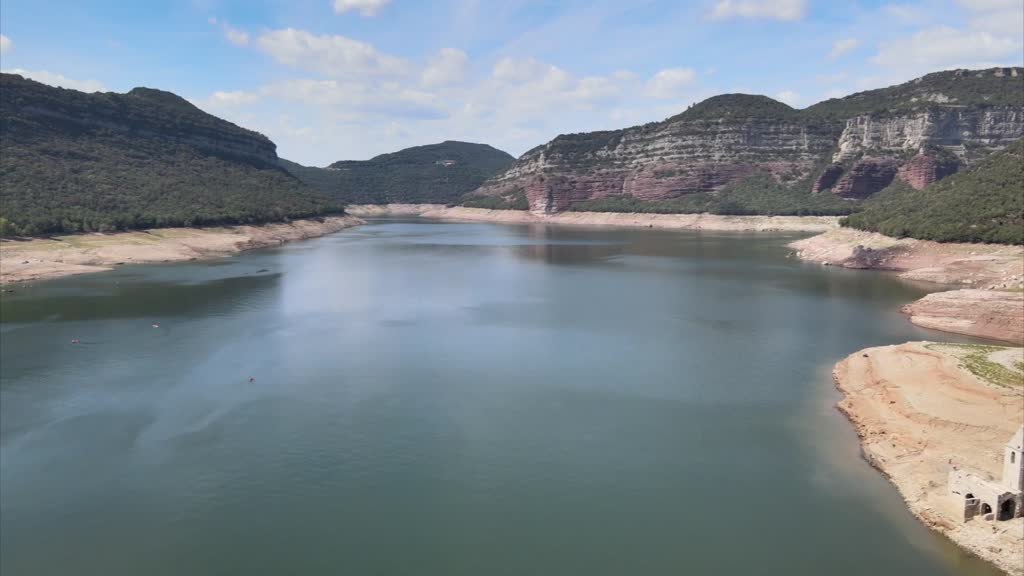Ancient Roman ruins, submerged church resurface as drought shrinks reservoir in Spain
SANT ROMA DE SAU, SPAIN - SEPTEMBER 19: Dropped water level in a reservoir has revealed ancient ruins and a historical monastery in Spain which has been hit particularly hard, battered by extreme drought.Spain is in the midst of the fourth-driest year on record, the country’s meteorological agency AEMET said last July.Since the rainy season began in October 2021, it has rained 36% less than average in the country, according to AEMET.In Catalonia, where 2021 was the driest year on record, authorities are on the verge of issuing a “pre-alert” for drought, local daily La Vanguardia reported last February.The archaeological remains of the entire Roman camp, known as Aquis Querquennis, and a historical monastery emerged when the waters receded at the Sau Reservoir in the town of Sant Roma de Sau in eastern the Catalonia region.The reservoir was created in 1960 on the site of San Romà de Sau, a village that had been inhabited for a millennium.Very small, the pointed spire of the church could be seen from anywhere in the surrounding hills for the last 50 years, but the monastery is now visible in its entirety with the cemetery next to it after the prolonged drought caused water levels to drop in Spain.The 1,000-year-old city with breathtaking Romanesque ruins and the monastery on dry land has been drawing tourists for the last several months.Speaking to Anadolu Agency Video News, Spanish tourist Meritxell Roca who tours the region by motorcycle every year, said they “saw extraordinary scenery” as the water level dropped and the old structures resurfaced this year.“This is the second time in 50 years that I have witnessed such a thing,” said Roca.“Normally only the top of the church was visible, now the entire church and the cemeteries can be seen,” she added.Last February the ruins of Aceredo, a ghost village that has under waters of a dam on the Limia River in the northwest of the country since 1992, was resurfaced.Spain's water reserves have dropped to their lowest level since 1995, according to data released on September 6 by the Spanish Environment Ministry.After dry summer of record-breaking heat, the country's reservoirs are filled to just 35% of their capacity, and several areas are suffering from a prolonged drought.The lack of rain is also taking a toll on the economy. As rivers run dry, Spain's much-needed hydroelectricity generation has plummeted 34% below the historical average for this week.Meanwhile, the association Asaja estimates that the lack of rains could contribute to losses of around €8 billion ($7.9 billion) in the agricultural sector. Hard-hit crops include high earners like olives, wine, almonds, and sunflowers.During Spain's drought in the first half of the 1990s, millions of residents and tourists had to live with significant water restrictions.Environmentalists are also concerned by the dramatic scenes in one of Europe's most significant wetlands. In Spain's Donana national park, the largest permanent lake has been reduced to a little more than a puddle.The tinderbox conditions in Spain this summer also gave rise to the worst wildfire season so far this century.Meteorologists forecast that this autumn in Spain will also be hotter and drier than normal.Much of southern Spain could even be turned into a desert by the end of the century if temperatures and greenhouse gases continue to rise unchecked, according to a 2016 paper published in Science.
640 x 360 px
1920 x 1080 px
For purchase and detailed information, you can contact us via the e-mail address aisales@aa.com.tr
Information
- IdAA-28947737
- Date20.09.2022 13:06
- CameramanAhmet Abbasi
- Clip Lenght00:04:10
- CategoryNews
- LocationSpain-Spain
- SourceAA
More From This Series
 NSosyal
NSosyal
